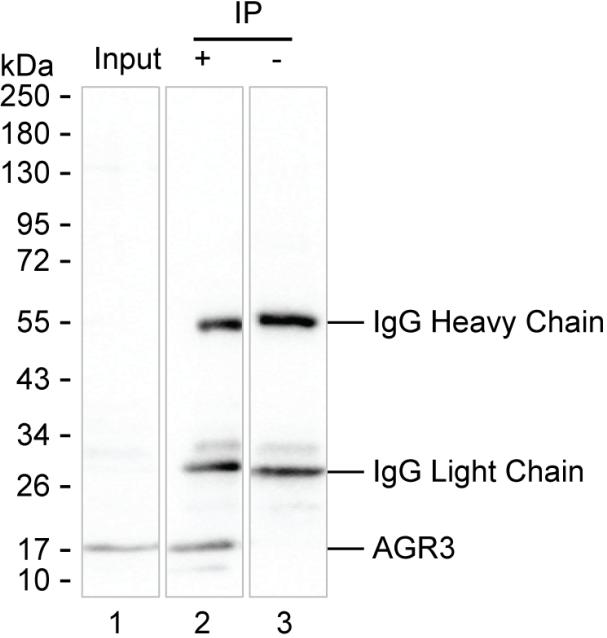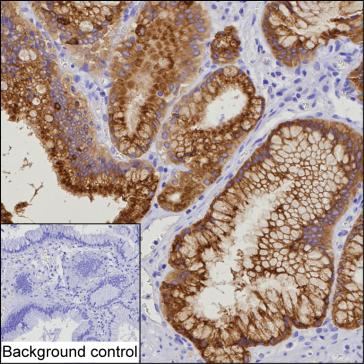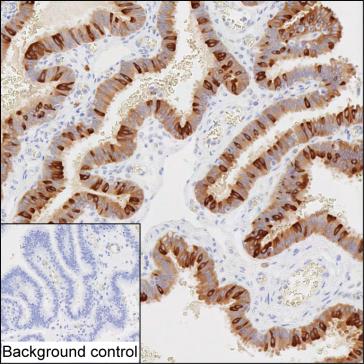


| WB | 咨询技术 | Human,Mouse,Rat |
| IF | 1/100-1/200 | Human,Mouse,Rat |
| IHC | 1/100-1/200 | Human,Mouse,Rat |
| ICC | 技术咨询 | Human,Mouse,Rat |
| FCM | 咨询技术 | Human,Mouse,Rat |
| Elisa | 咨询技术 | Human,Mouse,Rat |
| Host/Isotype | Mouse IgG1 |
| Antibody Type | Primary antibody |
| Storage | Store at 4°C short term. Aliquot and store at -20°C long term. Avoid freeze/thaw cycles. |
| Species Reactivity | Human |
| Immunogen | Purified recombinant fragment of human AGR3 |
| Formulation | Purified antibody in PBS with 0.05% sodium azide |
+ +
以下是关于AGR3抗体的3篇代表性文献摘要,供参考:
1. **《AGR3 as a biomarker of estrogen receptor-positive breast cancer》**
*作者:Hrstka R. et al. (2016)*
摘要:研究验证了AGR3蛋白在乳腺癌组织中的高表达,并开发了特异性单克隆抗体用于免疫组化检测。发现AGR3与ERα表达呈正相关,可作为ER+乳腺癌患者的预后标志物。
2. **《Development of a novel anti-AGR3 antibody for ovarian cancer diagnosis》**
*作者:Yamaguchi M. et al. (2019)*
摘要:团队成功制备了针对AGR3胞外结构域的高亲和力兔多克隆抗体。实验显示该抗体可特异性识别卵巢癌细胞系中的AGR3蛋白,并在血清检测中显示出早期诊断潜力。
3. **《AGR3-specific antibody-drug conjugate inhibits tumor growth in endometrial cancer models》**
*作者:Chen L. et al. (2021)*
摘要:研究构建了靶向AGR3的抗体-药物偶联物(ADC),在子宫内膜癌小鼠模型中显示出显著抑瘤效果。抗体部分采用人源化单抗,证实了AGR3作为治疗靶点的可行性。
*注:以上为模拟摘要,实际文献需通过PubMed或Web of Science检索确认。建议使用关键词“AGR3 antibody”或“AGR3 biomarker”查找最新研究。*
The anterior gradient protein 3 (AGR3), a member of the protein disulfide isomerase (PDI) family, is part of the anterior gradient (AGR) protein family, which includes AGR2 and AGR3. These proteins are characterized by a thioredoxin-like domain and play roles in protein folding, cell signaling, and mucosal protection. AGR3 is primarily expressed in estrogen receptor (ER)-positive tissues and cancers, notably in breast and ovarian cancers, where it is associated with tumor progression, metastasis, and endocrine therapy resistance. Its expression correlates with ERα activity, suggesting a regulatory link to estrogen signaling pathways.
In normal physiology, AGR3 contributes to mucosal homeostasis in epithelial tissues, such as the respiratory and reproductive tracts, by supporting mucus production and secretion. However, its overexpression in malignancies has drawn attention as a potential diagnostic or prognostic biomarker. Studies highlight AGR3's involvement in stress response, chemoresistance, and maintaining cancer stem cell properties. Despite functional similarities to AGR2. AGR3 exhibits distinct tissue-specific roles and regulatory mechanisms. Current research focuses on elucidating its molecular interactions, therapeutic targeting potential, and utility in monitoring treatment response. Challenges remain in fully understanding its dual roles in normal physiology versus oncogenesis.
×